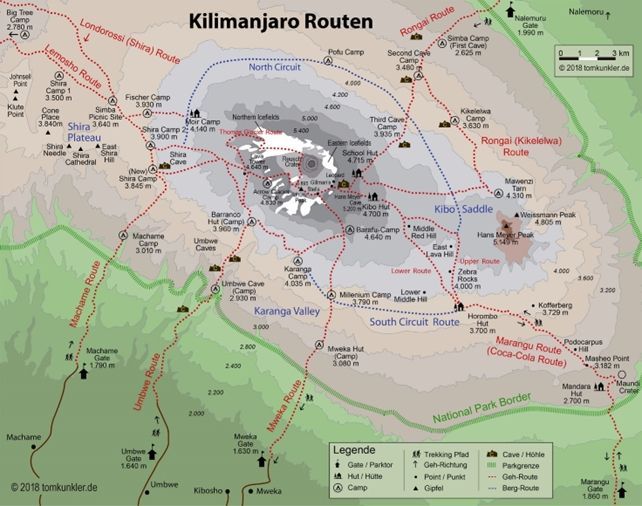Climbing Kilimanjaro


Kilimanjaro (also Kilimanjaro Massif, from 1902 to 1964 Kaiser Wilhelm Spitze or Wilhelmskuppe, English Kilimanjaro or Mount Kilimanjaro) is a mountain massif in northeastern Tanzania. The highest mountain in the massif is Kibo at 5895 m. Kibo is the highest mountain in Africa and is therefore one of the Seven Summits, the highest mountains on each of the seven continents.
In 1987, the landscape was declared a UNESCO World Heritage Site. Kilimanjaro National Park has existed since 1973. Kilimanjaro's ice cap is severely and increasingly affected by global warming: between 1912 and 2020, the ice layer has already shrunk by 85 percent and is expected to have disappeared completely by 2030.
There are different routes to reach the summit:
While the five routes Mweka, Umbwe, Lemosho, Shira and Rongai are rarely used, the Marangu and Machame routes are much more popular. According to park statistics, the most used Marangu route ("Coca-Cola route"), which runs in the southeast of the Kilimanjaro massif, is the only route that offers overnight accommodation in huts instead of tents and has a maximum quota of 70 guests per day.
National Parks in Uganda
-
Marangu RouteSupposedly the "easiest" route with the comfort of overnight stays in huts. 6-day trekking tour (approx. 4 - 7 hours daily). Summit day 12 - 14 hours.
-
Machame-RouteMost scenic route 7-day trekking tour (3 - 7 hours daily) Summit day approx. 14 hours
-
Lemosho RouteThe untouched and longest route with very good altitude adaptation 8-day trekking tour (4 - 8 hours daily) Summit day 13 - 15 hours
How fit do you have to be to make the climb?
Marangu Route:
Since you can choose your own pace, you can control most of the ascent via the Marangu Route. Mountaineering experience is not a must, but you should be in good shape. After all, you are going to an altitude of 6000 m. If you do a lot of sport, this should not be a problem. To prepare, we recommend that you hike longer distances several times beforehand so that your body gets used to the long walks. The paths on the Marangu Route are easy to walk and safe. The nice thing about this route is the variety.
The Marangu Route is prone to altitude sickness due to the large daily elevation changes. However, you can reduce the chances of getting it by adding an extra acclimatization day between days 3 and 4. This will add a day to the climb as you will spend an extra day at Horombo Hut. On this day you can either rest or take a walk higher up so your body can already get used to this altitude. This will increase your chances of reaching the summit of Kilimanjaro.
Machame and Lemosho Route:
Since you can choose your own pace, you can control most of the ascent on the Machame/Lemosho route. Experience in mountaineering is not a must, but you should be in good shape. After all, you are going to an altitude of 6000 m. If you do a lot of sport, this should not be a problem. To prepare, we recommend that you hike longer distances more often beforehand so that your body gets used to the long walks. The paths on the Machame/Lemosho route are easy to walk and safe. The nice thing about this route is the variety. The likelihood of suffering from altitude sickness on this route is lower than on other routes because the climbs are well distributed over the day. If you want to keep the risk of getting sick as low as possible, we recommend that you book an extra acclimatization day. In this case, the trekking tour is extended by one day. The extra day increases the likelihood of reaching the summit of Kilimanjaro because you give your body more time to get used to the altitude.
What equipment do you need?
- Duffel bag(60-90L)
- Hiking backpack(max 35L)
- Trekking shoes
- Mountain boots
- Winter hiking jacket
- Lightweight fleece jacket
- Rain jacket– Rain pants
- Trekking poles Merino T-Shirt (1 to 2 pcs.)Hiking pants Hiking socks(2 pairs)GlovesLong underwearLong merino topHeadgear
- Light shoes for camp (optional)
- Headlamp
- sunglasses


